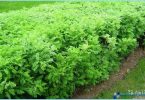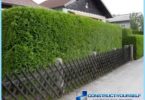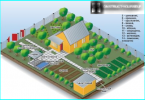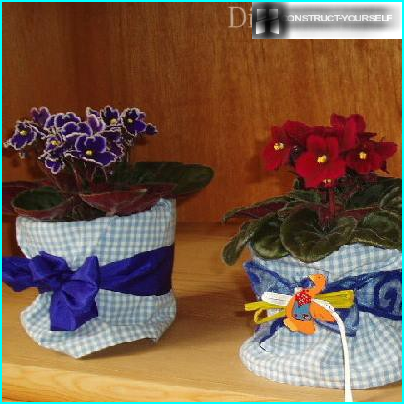
Many Housewives are getting rid of flower beds, replacing them with grass in order to spend less time weeding and care. But really, for lawn grass should be looking out for anything less than roses or ornamental shrubs. When poor-quality care grass can get sick, be affected by pests, making them a decorative effect greatly reduced. In the end, instead of a beautiful lawn will turn out lifeless, covered with bald spots and yellowing grass plot, which spoils the whole design. Any lawn disease is easier to prevent than then to restore the turf from scratch. Consider the most effective measures for the prevention and treatment of lawn grasses affected by diseases or damaged by pests.
The contents
Preventive measures lawn care
Every doctor will tell you that maintaining health is much easier than to get rid of old sores. This applies not only to humans but also plants. If the disease will pass to a running stage, the only way of salvation, the grass is cut pieces of the affected turf and a complete replacement at this point in the ground. Meanwhile, most diseases can be prevented with proper care. So, the main event, keeping the turf healthy:
Elimination of excess moisture and standing water
Increased soil moisture is the best factor for the development of fungal infections. The more compacted the soil, the harder the roots to breathe. If you notice that the water stands after rains on the lawn puddles, should be applied with special devices or ordinary garden fork, pinhole the ground in many places.
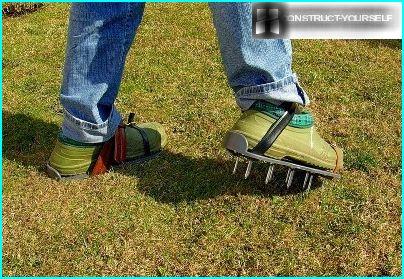
Good access of oxygen to the roots and makes the turf more developed and resistant to most infections, as aeration helps to avoid water stagnation
Timely cleaning of the felt
The dying blades of grass gradually accumulate on the lawn and interfere with normal growth of the rest of the grass. Their drying stems cover the ground a carpet, and prevent proper ventilation. Hence the excess moisture and rot the roots. To avoid problems will help the timely sweep of the lawn with a rake. If mow trimmer with the comb simultaneously with the harvesting of the crop. But the owners, who cut their lawn mowers, it is necessary additionally to take up a rake for combing out felt.
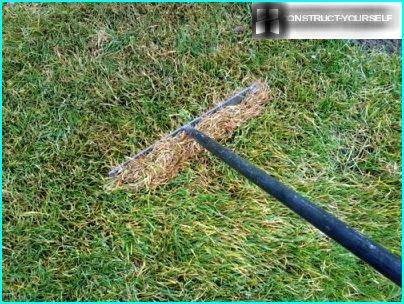
The dying blades of grass accumulate at the ground a carpet, creating the perfect conditions for reproduction of spore infection, as the felt is always wet
Competent top dressing fertilizer
There is a rule that the closer to autumn the less nitrogen should be applied to the soil. Nitrogen causes an excess of green mass, weakening the root system, and in the fall is desirable. In the winter, it is the roots have to go healthy so next spring to give good grass. Therefore, the nitrogen introduced in the spring to mid-summer, and by autumn only feed phosphorus-potassium fertilizers.
Preventive measures in the winter
In winter, the root system of grasses is fragile and spoils quickly, if for her to walk as active as in the summer or fall. Ideally, in the winter do not walk on the lawn, but sometimes he is just on the way to the outhouses or the gate. In this case, put on the snow Board and walk on it. This is a more gentle option than trampling the frozen turf shoes.
If all the above steps you use regularly, but the lawn is still not happy appearance, it is necessary to understand how the disease or pest it wears away. The sooner you start fighting, the faster will destroy the infection until it captured the entire lawn.
The most frequent disease of lawn grasses
All diseases herbs can be divided into two groups: infectious and parasitic. Infectious strike the plants themselves. Their spores penetrate the stems or roots, causing dieback of grass. Parasitic – colonization of the turf in other microorganisms (fungi, lichens, algae), which are gradually replacing the turf with a lived-in area, conquering it more and more territory.
Plants have susceptibility to different infections. Of the lawn grasses most susceptible to diseases of Kentucky bluegrass and all kinds of osanic. If they are in mixtures planted on your lawn, then care must be particularly careful. Among the most frequent diseases of turf are the following:
Disease #1 — Fusarium
The disease is transmitted through infected soil or through the air, so if your neighbors lawn is already sore, the spores will fly and before you. The period of infection from late fall to early spring. Pathogen the fungus Fusarium is highly resistant to low temperatures. He will survive and at -50°, although the greatest development is observed at temperatures of zero to -5°, during the thaw and wet weather. The signs of the disease appear in early spring. Thawed on the lawn you will see a silvery or slightly pinkish spot glued the grass. The diameter of the spots from 2 cm to 20. Because the grass seems to be covered with snow, the infection is also called «snow mold». Gradually, the grass will dry and become straw.
If the stain is small, you should immediately treat their systemic fungicide, like carbendazim. Large stains talking about severe cases of turf. In this case, sprayed with a fungicide the entire plot, and from the infected turf is completely removed along with the top layer of soil and re-sow with grass.
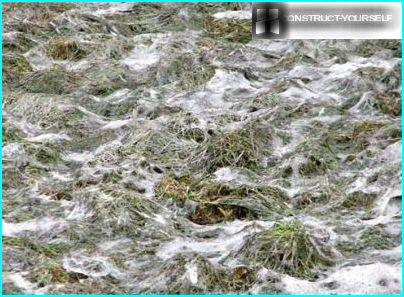
The most frequent infection called snow mold, or Fusarium, easily recognized by a silvery-gray patina on the blades of grass, resembling the web or slightly melted snow
Disease #2 — powdery mildew
A very well-known infection which affects many horticultural crops. Actively developing a wet summer. Appears white bloom on the grass, reminiscent of cotton wool or foam. Gradually darkens and thickens, and with it dry and the grass.
Most often, the appearance of powdery mildew is to blame moisture and excess nitrogen fertilizer. Stop to feed the lawn, treat with a fungicide and carefully comb out the fan rake. Before winter once again apply fungicide, then be sure to bevel, to prevent the fungus winter on the stems, and treat the chemical drug again. Spring complete feeding.

Flakes of white foam on the grass — a signal that the lawn has settled powdery mildew. And it is better to start the fight as early as possible
Disease #3 — rust
The disease has several varieties, but all of them are easy to spot on the stems of grasses in different shades of orange and yellow tones. The lawn looks affected rusty spots. Most often, infection results in weak illumination lawn and the lack of minerals in the soil. Good to fertilize turf during a dry summer – naladte regular watering, and the affected areas skachivaya 2-3 days until you grow healthy stems.
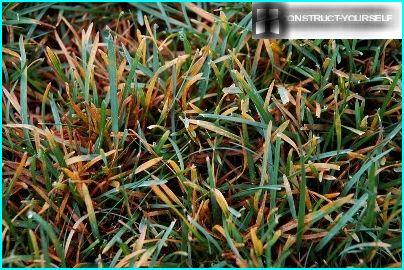
If the lawn started to turn yellow don’t late autumn and in the spring or summer, it struck such an infectious disease like rust. The lack of power the roots
Disease #4 — red niewinnosci
The most eloquent proof of the unkempt lawn. Reminded of may or in the fall. The grass is starting to get colour back, but if you look closely, the color give the red stems filiform spores, entangling the aboveground part of herbs. The appearance of the lawn immediately spoiled, and some areas gradually shrink. High combat the disease there. Enough to feed the turf, sweep it to remove debris, and improve aeration.
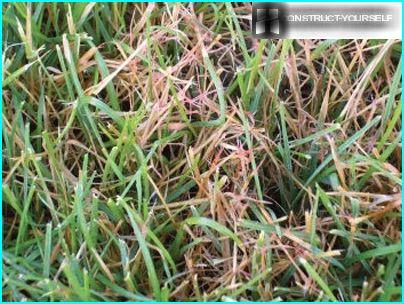
Pinkish spots on the lawn are the result of life harmful spores, which entwine themselves aboveground part of the grass, causing the plants to death
Parasitic diseases
Parasitic plants (mosses, lichens, algae, fungi) live only in well-groomed lawns, where the grass is weakened due to poor nutrition, lack of drainage and compaction of the soil. If the turf is healthy, he will compete for territory and special assistance is not required here.
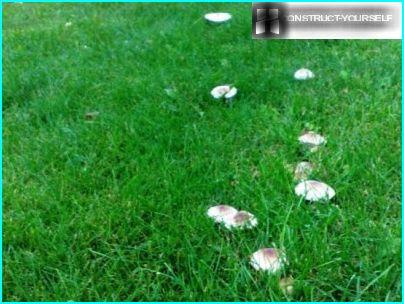
If mushrooms on the lawn a little, they are not dangerous and even useful for grass, as the mycelium feeds the roots with beneficial trace elements
To eliminate lichens first spend liming, reducing excess acidity. Often this is enough to bring the parasite. The second step should be the systematic feeding that will improve the health of the lawn. The occurrence of algae is the result of compacted soil and weak drainage. If you establish aeration and from time to time to sweep the grass, the problem will disappear by itself. Mushrooms are actively developing there, full of organic remains (fruit cores, and dead grass, etc.). If you allow the lawn to burn all the garbage, then the mycelium gradually weaken and disappear.
Pests of grass and the ways of their destruction
In addition to diseases on the lawn to eat many living creatures, but insects among them play the most minor role. The damage of the grass grain mite wireworm or Swedish fly is not so essential, and if the turf is healthy, he quickly pulls the damaged area.
More serious pests of the lawn is moles, ants and earthworms. Their tireless work lead to the appearance on the lawn of mounds of earth, grass which naturally, kills.
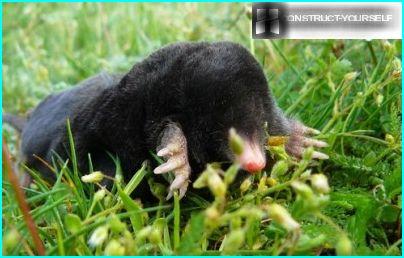
The more fertile soil under the lawn grass, the faster it will settle the mole, looking for prey in the form of earthworms
Options to get rid of moles you can learn from our article «Fighting moles in the suburban area: an overview of some humane ways». We will consider in more detail how to get rid of ants and earthworms.
War with the ants: repel and herbs
Ant mounds can appear on the lawn in only two cases: if there – fruit trees, on which they can graze aphids and if the grass planted on the sand. It is easy to make a deep nest. To destroy all «the herd», the easiest way to handle an ant is strong chemicals. Particularly good gels as they apply to ant path and drip in several places on top of an anthill. Insects pull «treat» deep and feed them all, including females. Tomorrow the mound is littered with corpses. You have to level the soil and to interplant the grass.
If ants in your yard are frequent visitors, it is best to deal with them method of scaring. On the lawn you can sprinkle red pepper flakes or cinnamon. They do not harm the grass, but the insects can’t stand strong smells.
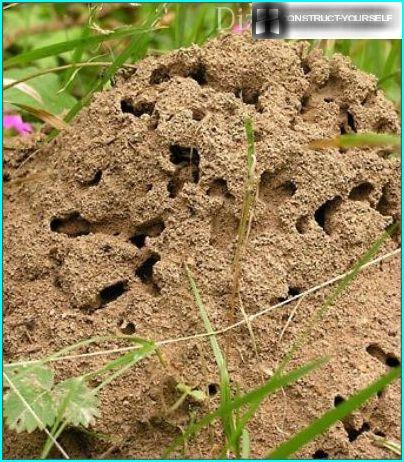
Sandy soils are a real treasure for ants. They can build nests in them the great height, if you do not take action for their hazing
Earthworms: move to the garden
Sometimes on the lawn, there are many earthworms. Rather, we see them, and the traces of the holes across the lawn and piles of excrement. If the lawn no one goes, the mounds will quickly heal. But on the lawn where the owners used to vacation, such places are pritupleny, and the grass flattened. This will result in bald spots.
To destroy earthworms is not accepted, because they are perfectly loosen the soil. You just need to get them to get off the lawn into the nearest flower bed or the vegetable garden. To do this, quit watering the lawn and backfill it with sand. Worms do not like dry places and will crawl to where more wet. You can also wait for heavy rain and right after it go on the lawn. The shower flooded the moves of worms, and they crawl out in search of oxygen. It is here that you get them warm and take. Collect in a jar and take to the beds.
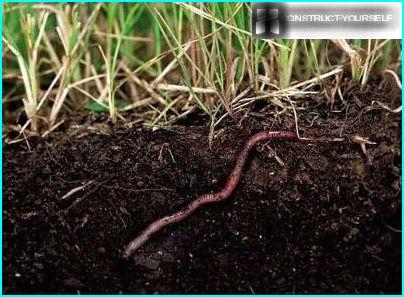
Earthworms are perfectly ventilate the soil and improve its drainage properties, but the appearance of the lawn, dotted with mounds of soil, not very aesthetic
A lot of damage is caused the grass and the dogs who dig holes, but to blame the owner allowing an animal to run free on the site.

